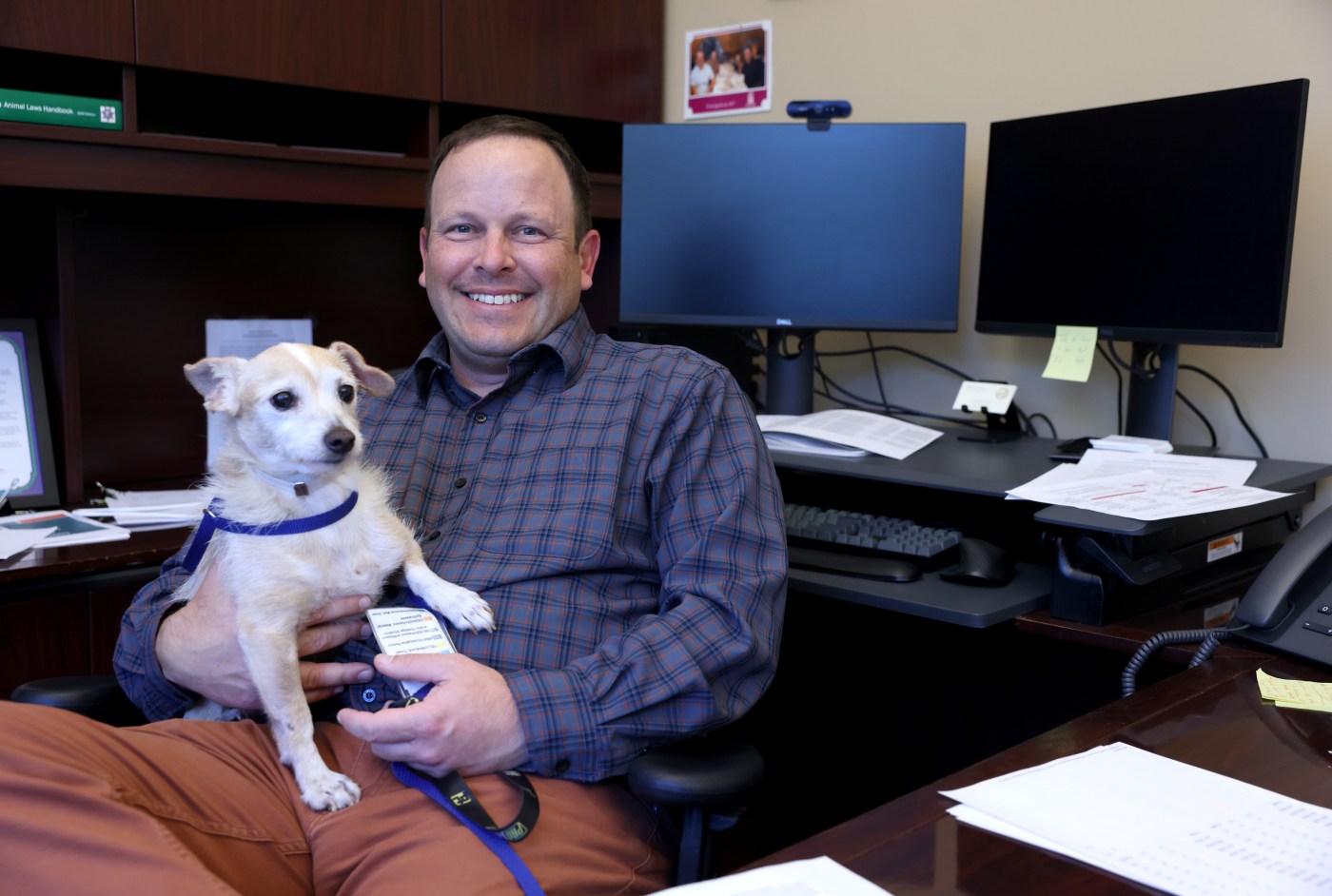MARTINEZ — Whether an animal is lost, dangerous or neglected, Contra Costa County’s Animal Services Department (CCAS) plays a crucial role in protecting the health and safety of pets, wildlife and residents.
The department, which acts as the primary shelter for 18 cities and the county’s incorporated communities, received nearly 20,000 calls for service last fiscal year — a 7% uptick from the previous annual demand, which leadership attributes to the region’s growing population and increased awareness of CCAS’ safety net of services.
Related Articles
Crossing the border with your dog? The U.S. just changed the rules.
Leave your dogs at home for this weekend’s CatVideoFest 2024
Puppies saved from Park Fire were ‘all over the place’ in rescue chopper
Bay Area man wonders if hummingbirds ever crash into humans
Booties. Indoor dog parks. And following the vet’s orders. How to keep pets cool this summer
Ben Winkleblack, a certified animal welfare administrator, became the new big dog in charge in May — permanently taking the reins after former Director Beth Ward retired in January.
Winkleblack began his career in 2006, working as an animal health technician in Santa Cruz County before a decade-long tenure as shelter manager. He served as assistant director for Oakland Animal Services in 2020, and most recently consulted for the Humane Society of St. Thomas in the U.S. Virgin Islands.
Now based in Martinez, Winkleblack has since kept busy filling ice buckets to help keep dog kennels cool, analyzing program data, compiling reports for fiscal year 2023-24 and answering local officials’ inquiries about the department’s diverse range of services.
Winkleblack took time to give his initial thoughts about the department’s past and vision for the future of Contra Costa County’s Animal Services.
Q: With the first few weeks under your belt, how well do you think the agency is managing its mission?
A: One thing that I’m seeing is animals are staying here longer. The average length of stay has increased because we have more coming in than we have going out. And the longer they stay, the harder it is to find the best solutions for these animals. We need to be really proactive in that.
I’ve seen that the number of animals that went to placement partners and nonprofit rescue groups has decreased 16% when compared to the previous fiscal year — the driving reason I’m trying to meet with those organizations. I think data is very useful to really size up the issue. We’re having to work harder and harder to get outcomes for these animals, but we’ve already increased our adoptions by 13% compared to last fiscal year — an ideal, but hard-fought outcome.
Q: What services does CCAS provide?
A: Animal Services today is not what it was 20 years ago. We are trying to offer more wrap-around services. For example, rather than just picking up a stray dog, now we’re considering why that dog is stray — whether a gate was accidentally left open, the animal was actually abandoned, an unhoused resident lost track of their pet or a dozen of other reasons.
We are also a public safety agency, so we investigate dog bites and quarantine animals involved for observation to make sure that they aren’t showing signs of rabies. We investigate calls for cruelty and neglect, many of which are unfounded, but some that are truly heartbreaking situations. Neglect can also be driven by people not understanding what is truly appropriate care for an animal, so we try to educate when we can, but sometimes we investigate and look towards prosecution.
Every situation is looked at in a vacuum, and that’s part of the magic of animal services. We have the ability to ask why someone needs to relinquish an animal or answer questions about basic care needs, because maybe there’s something we can do to help people not have to surrender their animals and pets.
Q: The county recently recommended setting $18.2 million aside in its 2024-25 budget for the Animals Services Department. What is the best use of that funding?
A: I’m too new to the agency to really understand what our budget looks like in action, but it’s really important to target your resources in this field, because none of us have enough. I like to have a big-picture look at what is driving animals to the shelter. Is it that people are losing their housing? Are they unable to afford their pets or provide the care that they need? Understanding these questions helps us understand the clients that are coming in and plan for the future.
It’s easy to get into a routine where you do the same thing again year after year unless you’re looking at what the numbers tell you. We may need to switch our focus a little bit, evaluate aspects of the agency or even just look at what’s going on in the community that would be missed if we’re just looking at the day-to-day operations.
I know it’s a cop out to say, but covid changed everything — no one’s numbers are the same as they were before the pandemic. One thing I can say is that we are transferring fewer to those partner organizations. During the pandemic, the cost of business went up — impacting both veterinary service bills and even the accessibility of veterinarian visits. It’s a hard reality for us as the big players, but it’s even harder for the little guys. They’re often paying their bills through donations and adoption fees, so if their cost to provide veterinary care doubled in the last few years, then the capacity to take animals into their care is probably cut in half.
I’ve been in this field for a long time, and animal shelters are constantly in a state of reaction. But I want to help residents before we get to a point of surrender because owners can’t pay for medical care or handle an unwanted litter. We try to be involved with the proactive part of animal welfare, rather than just sitting here and having to deal with the consequences.
Q: Staffing and operational issues have recently come to light at several Bay Area animal welfare agencies, including the city of San Jose’s shelter. Should residents worry about the state of animal welfare in Contra Costa County?
A: Part of the reason that I’ve had a lot of training and certification is that I want to make sure that I’m keeping best practices in mind when we make decisions. I also think that transparency is really important, because every shelter out there may get to a place where we are at a potential tipping point. While I can’t say this for sure, I don’t think any place that is getting audited was doing anything that they didn’t have to do. They were likely saddled with an unclimbable hill and probably trying their best. Maybe they didn’t have appropriate staffing or funding to maintain adequate facilities.
I work really hands on with staff — who are the eyes, ears and boots on the ground doing the work — because I believe that when (agencies get audited), it’s because they were in a really tough situation. I certainly read those reports — we need to be aware of those problems so we can learn and try not to repeat them.
Q: How do you hope to combat the chronic issues threatening local animal welfare services?
A: There are no silver bullets in this field. But I’ve been in the field for a long time, so I’m going to try to utilize every trick that I’ve learned to make sure that whatever practices we do here are sustainable. We have great partners in this area, and I think if we can all collaborate, we can make Contra Costa County a beacon for other agencies in the state. That’s my hope.
Ben Winkleblack
Company: Contra Costa County
Role: Director, Animal Services
Age: 44
Salary: $191,660
Pets: Fern, an 8-pound Chihuahua, which he recently adopted from the county’s shelter
Inspired by Winkleblack’s newest family member, here are five other animals at CCAS awaiting adoption into a loving home:
Orange tiger Domestic Shorthair cat
8 years old, male (15 lbs)
Arrived at the shelter June 7
Tan and brown German Shepherd/Rottweiler
1 year and 2 months old, female (67 lbs)
Arrived at the shelter May 1
Gray and white Siberian Husky
7 years old, female (72 lbs)
Arrived at the shelter May 5
Black shorthaired Rabbit
3 years old, male
Arrived at the shelter July 13
Calico and white Domestic Shorthair cat
11 weeks old, female (3 lbs)
Arrived at the shelter June 13
If Hector, Lychee or any of these fuzzy friends have already been adopted, the shelter has dozens of wonderful animals that are still available and looking for homes, listed here on the county’s website.












